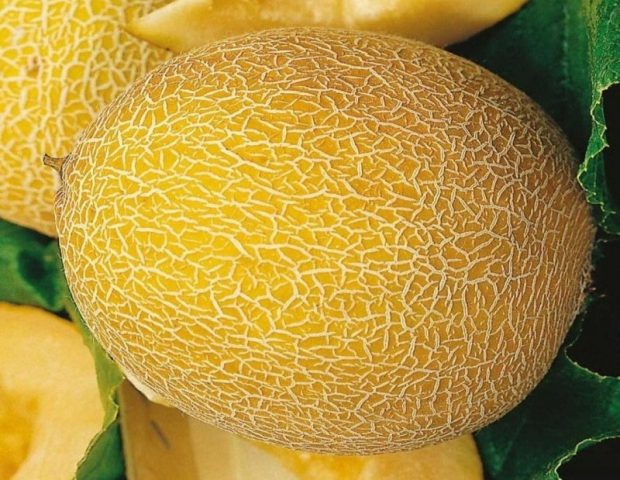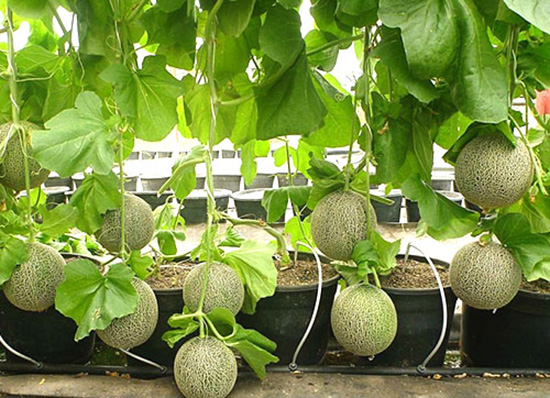Content
Originally from Northern and Asia Minor, melon, thanks to its sweetness and aroma, has long become popular in our area. In greenhouse conditions, melon can be grown in almost any region of the country without much effort. However, it is not necessary to have a summer house for this: the culture feels good on the balcony and even on the windowsill! Melon at home, photos, conditions for growing the vegetable and instructions are presented in detail in the article.
Melon varieties for growing at home
Growing melon at home is not as difficult as it seems at first glance. This crop does not require special care, and its fruits grown on a balcony are in no way inferior in taste to those obtained on an open plot of land. The most common varieties of melon for growing at home:
- Collective farmer. It has spherical, medium-sized fruits of orange-yellow color with a hard skin. The white, thin pulp sometimes contains a greenish layer closer to the skin. The fruit tastes very sweet and aromatic. Sugar content is 11.3%;
- Altai. The fruits are oval, lemon-colored, with yellowish or white dense pulp and viscous consistency. Sugar content 5 – 6.5%;
- Frost. The spherical or oval fruits are yellow (orange) in color and have a characteristic large mesh. They are distinguished by thin skin, sweet and juicy pulp with a sugar content of 8.4%;
- Lemon yellow. The fruits of lemon-yellow melon are slightly flattened, segmented, with small yellow spots. The pulp is very sweet and grainy. This variety is the leader in terms of sugar content (10 - 12%).
All varieties are early ripening and ripen in 80 - 85 days after planting, except for Frost, which is a mid-ripening variety and ripens in 90 - 92 days.
How to grow melon at home
The culture does not make any special demands, so anyone can grow it at home. Melon feels great when grown at home: it is enough to have a spacious balcony or wide window sill on the sunny side of the apartment. The only thing she needs to provide is temperature control, regular watering and good lighting. Since this is a southern crop, you can grow melon on the balcony only if the temperature at night drops at least 17 - 19°C.
At home, early-ripening and mid-ripening melon varieties with medium-sized fruits are usually grown. To ensure light and temperature conditions, the loggia must be equipped with special lamps. With a lack of lighting, the melon produces long shoots, and this is reflected in the number of ovaries and the sugar level in the fruits.
In the natural environment, melon shoots lie on the ground, but at home you cannot do without a trellis. It is not recommended to grow more than 4 - 5 bushes, since even this is enough to cover the entire balcony with shoots.If you plant more than five bushes, the melons will simply be crowded and there will not be enough lighting.
You can also pollinate with a regular brush, transferring pollen from male melon flowers to female ones. Male inflorescences differ from female inflorescences by the presence of a small embryo at the base of the ovary.
How to plant a melon at home
Not all varieties are suitable for growing this crop at home on a windowsill, but only small, small-fruited hybrids, for example:
- Sweet tooth;
- Cinderella;
- Honey.
Growing melon on a windowsill begins with sprouting seeds. For this purpose, a small container with soil mixture (for example, a plastic or special peat cup) is sufficient. After germination, melon seedlings are transplanted into separate 5 liter pots. To obtain a larger number of ovaries (that is, female inflorescences), seeds that are two to three years old are suitable. Last year's planting material usually produces more male inflorescences, that is, empty flowers.
When to plant
Typically, melon seeds are planted in the soil mixture in late April - early May, when the temperature at night does not drop below +17 °C. You can sow both dry seeds and those previously soaked in a germination stimulator (Bio Master or Energen Aqua).
Preparing soil and containers
Melon loves slightly alkaline, airtight, moderately moist soil, which can be achieved at home without much difficulty. The optimal composition of the soil will be: two parts turf soil, one part peat and one part humus. The planting container must have a drainage hole.
Landing algorithm
To speed up germination, the container with the planted seeds is covered with film.On the fourth or fifth day, when shoots appear, the film must be removed.
Algorithm for planting seeds:
- Fill the peat cup with soil mixture, leaving 2 - 3 cm to the edge.
- Pour boiling water over it and let the excess go out into the drainage hole.
- Wait until the soil in the cup reaches room temperature and place a seed in the center.
- Fill the soil mixture to the top and pour with warm water.
- Cover the container with film (can be covered with glass) and move to a warm place until germination.
Since melon does not tolerate transplantation well, it is recommended to immediately transfer the hatched seeds to a permanent pot. This simple technique for growing melon at home will allow you to get fragrant fruits within 2.5 months after the first shoots appear.
Growing melon on a balcony or windowsill
Any city dweller can grow a melon on a balcony at home, adhering to the rules of agricultural technology for this crop. Compliance with the light regime and watering schedule is not particularly difficult. And the process itself brings great pleasure to those who like to grow plants on the windowsill, especially when the first fruits ripen.
Light mode
Melon is a light-loving plant, so loggias and balconies on the sunny side of the house are suitable for growing it. If there is not enough sunlight, it is necessary to provide additional illumination by turning on an LED lamp for 14 - 16 hours a day. With a lack of light, the melon grows poorly, gets sick, and the fruits turn out small and unsweetened.
Watering schedule
Watering the melon should not be done very often: on average, once every 4 to 5 days or if the soil dries out completely. This should be done early in the morning or late in the evening with warm, settled water (approximately 30 - 32 °C).At the same time, make sure that moisture does not get on the leaves, inflorescences and fruits. In order not to harm the plant, it is recommended to water it by drip or in specially dug grooves around the root collar.
To make melon fruits more sugary, watering during the ripening period is reduced until completely eliminated by the time of ripening, otherwise the fruits will be watery and tasteless.
Do I need to feed
The first feeding of melon grown on the balcony is carried out with mineral fertilizers as soon as the plant has cotyledon leaves. The next time they feed is after seven days. Then, as the plant grows, it is fertilized 2-3 more times. Since melon, like all melons, is a potassium lover, the first two feedings are carried out with azophoska. To do this, dilute 3 tbsp in 10 liters of water. l. fertilizers From the beginning of the flowering period, the melon is fertilized with universal preparations, for example, Fertika Lux (add 20 g per bucket of water).
Garter
A melon grown at home must be tied up, since there is not enough space for the natural placement of its lashes. To do this, use twine or trellis. Due to the fact that this plant does not weave itself, it must be wrapped around a support and secured with a rope. The fruits also need tying: each is placed in a special net and attached to twine.
Formation of bushes
In order for a melon grown on a windowsill to be juicy and sweet, you should leave only one shoot, tying it to a trellis. The remaining shoots are removed. Usually no more than 3 ovaries are left, and when the fruits become the size of a fist, the top of the main vine is pinched. This is done so that the plant directs all its forces to the fruits, and does not spend them on increasing green mass.
Diseases and pests
Melons are susceptible to infectious fungal diseases. The most common:
- Fusarium wilt is a common fungal infection caused by the Fusarium fungus. It is difficult to recognize the problem externally, since the affected stems appear healthy. A diseased plant quickly dries out because as a result of the disease, root hairs on the roots disappear. Melons affected by the fungus completely lose their taste value;
- Anthracnose – The causative agent of this disease is the fungus Colletotrichum orbiculare. Affected leaves become covered with brown or whitish spots, and the stems become very fragile and break at the slightest gust of wind;
- Powdery mildew – a fungal disease caused by microscopic fungi Sphaerotheca fuliginea Poll living in the soil. Popularly this powdery mildew is also called ashtray or linen. The external manifestations of the disease look like a grayish-white coating on the shoots and leaves. Diseased leaves dry out and die, which delays the development of fruits, which on diseased shoots turn out small and tasteless.
The spread of diseases is facilitated by excessive soil moisture and high temperature (above 28 - 30 ° C). In addition, a lack of potassium and phosphorus fertilizers weakens the crop and increases the risk of infection. Therefore, at home on the loggia where melons are grown, it is not recommended to store vegetables brought from the market.
In addition to fungal infections, melons grown on the balcony have their own pests. The most common are:
- melon aphid;
- spider mite;
- gnawing cutworm;
- melon fly.
To prevent the appearance of pests, it is necessary to loosen the soil and weed out weeds, on the roots of which parasites like to live.In addition, it is recommended to spray the melon with special disinfectants (Formalin, Fundazol), an infusion of onion peels or a decoction of herbs (calendula, celandine, dandelion, wormwood).
Conclusion
Melon at home, the photo and description of which are given above, is a very real opportunity to enjoy a fruit grown with one’s own hands, outside the plot of land. With proper care, compliance with light and temperature conditions, as well as timely feeding, no special difficulties arise in apartment conditions. After all, how much more pleasant it is to eat a piece of melon grown personally than bought at the market.




















When should you tie up a melon?
Good afternoon.
When growing melon in a greenhouse, lashing begins 2-3 weeks after planting the seedlings. If we are talking about fruits, then they start gartering when their size exceeds 15 cm in diameter (that is, larger than a fist).